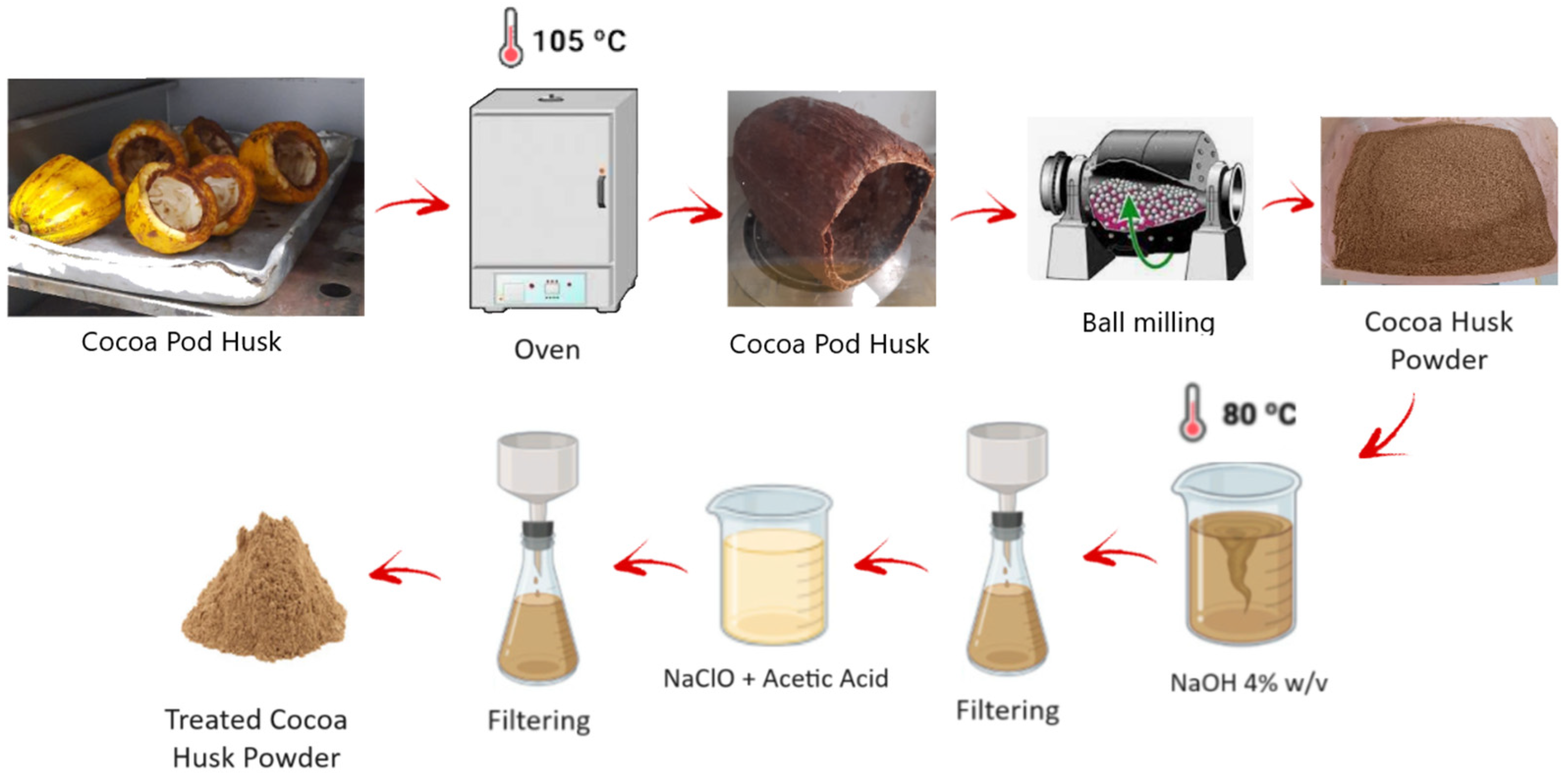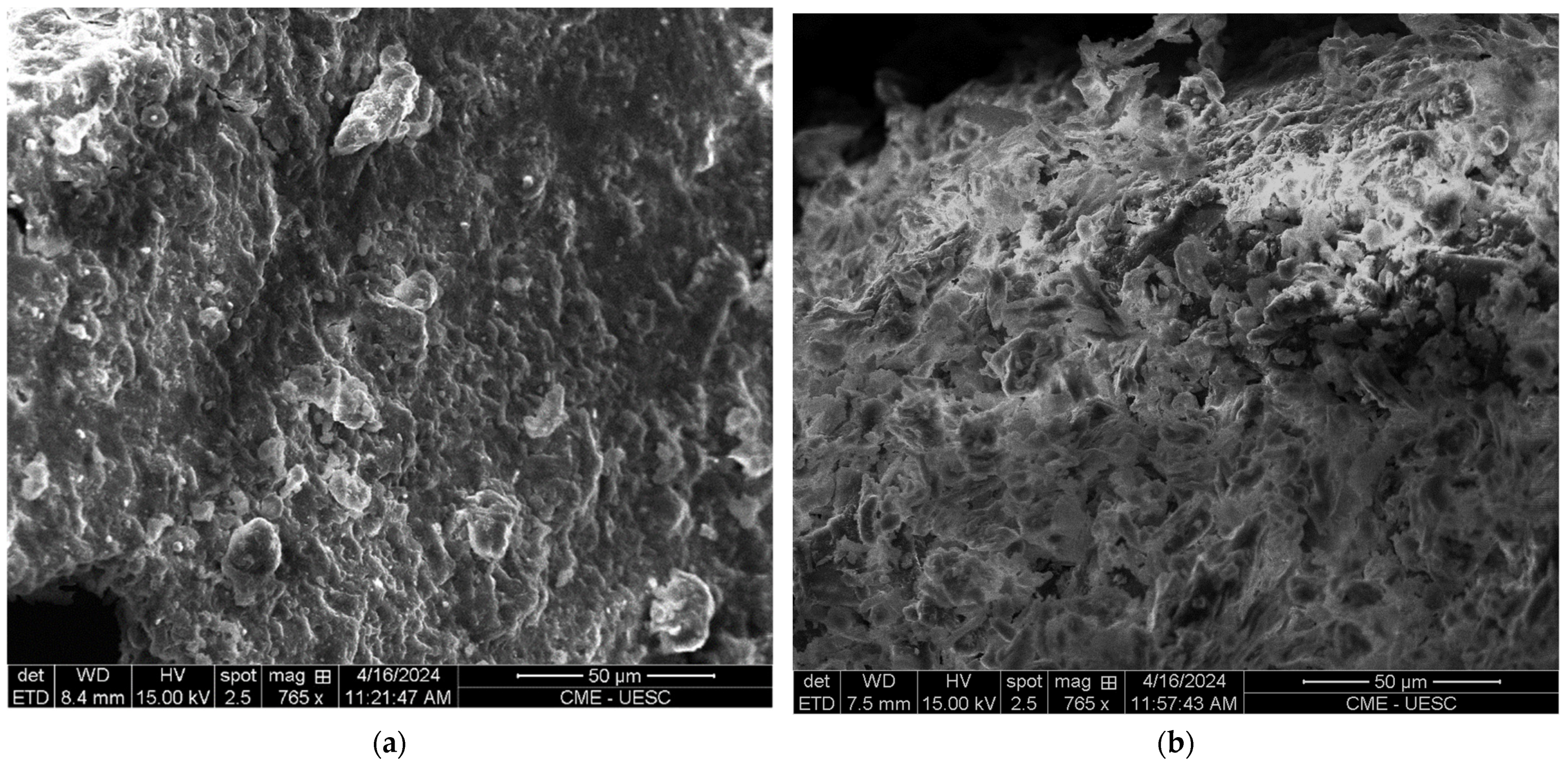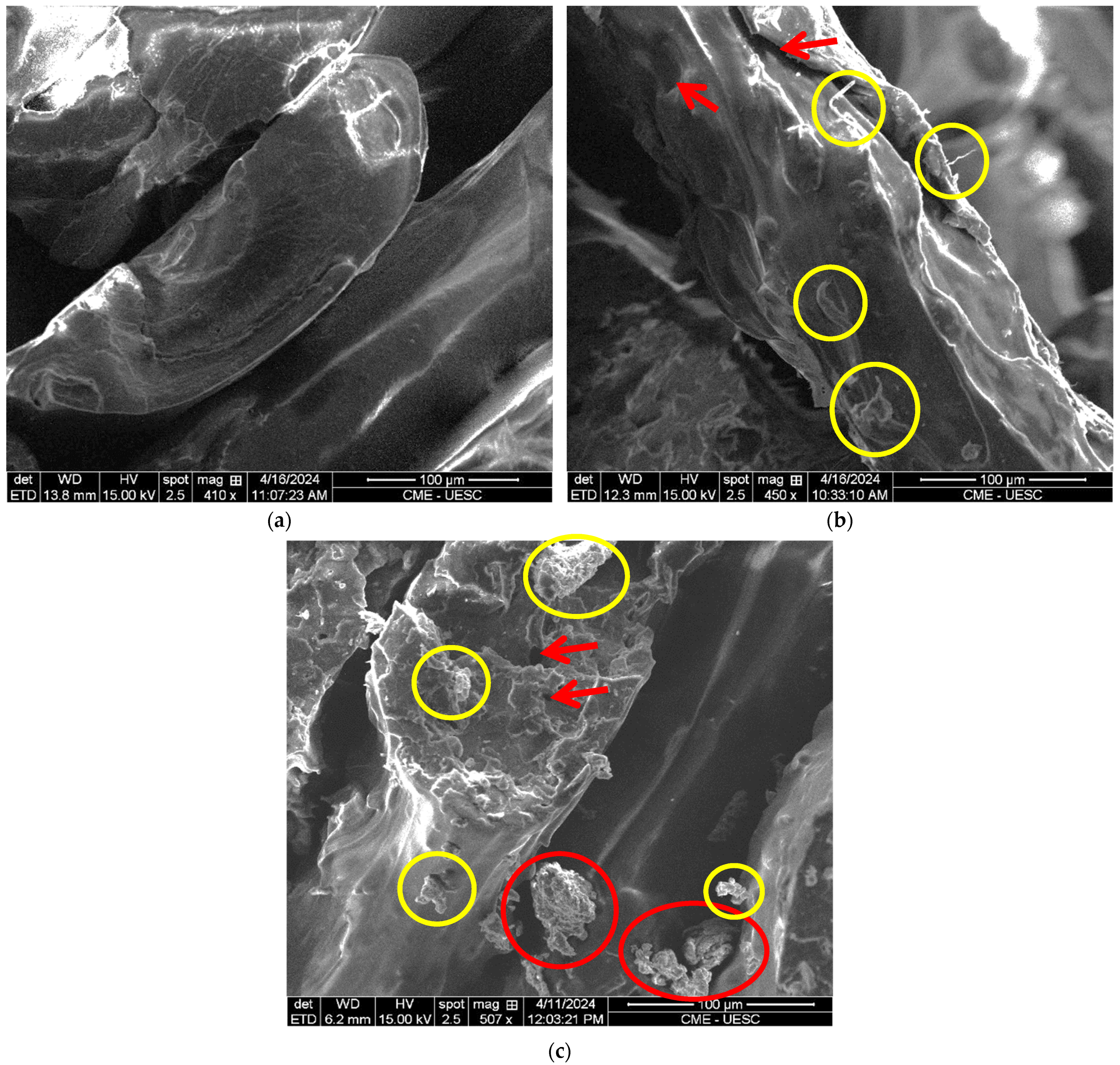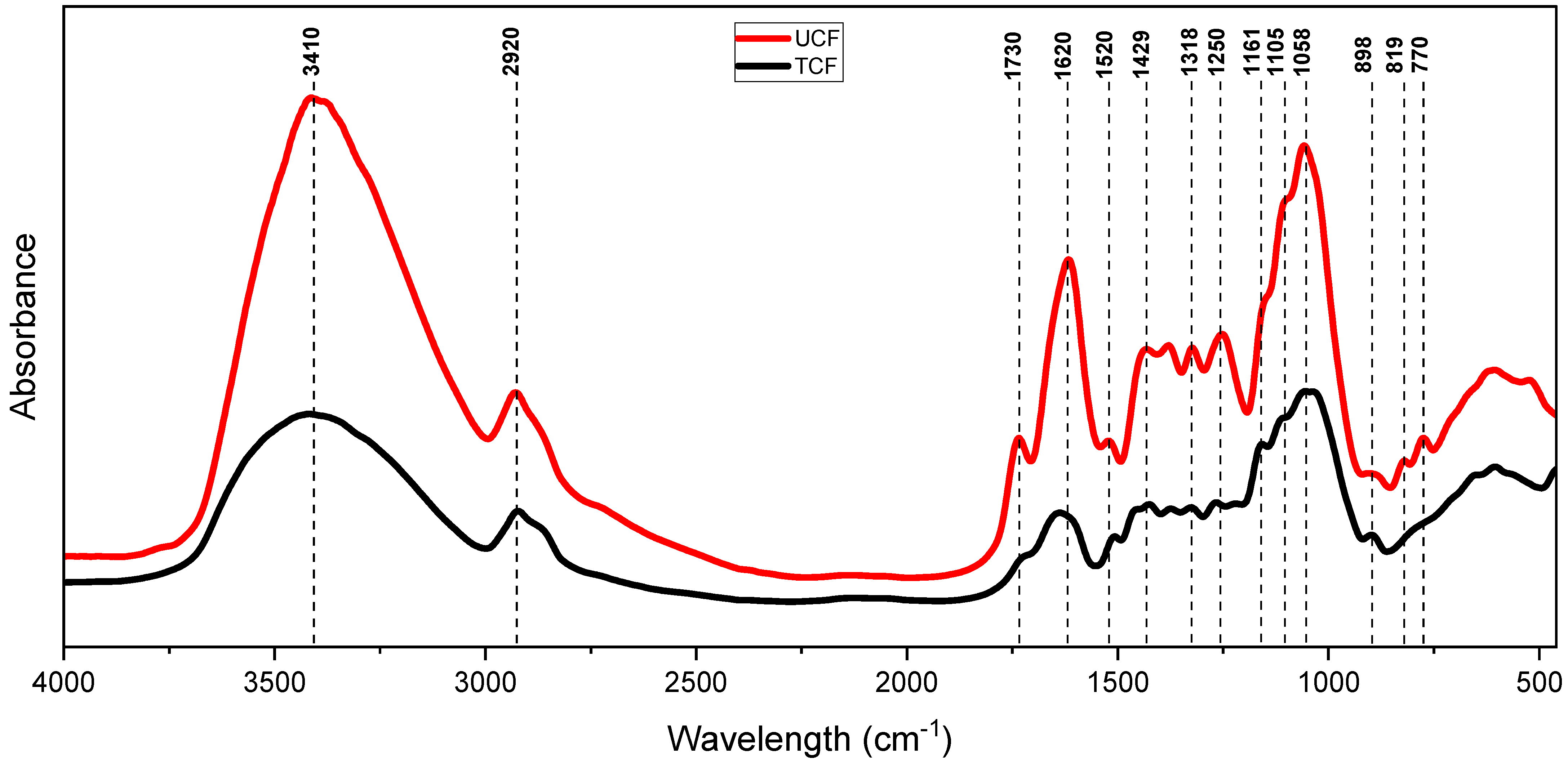The Development of Biocomposite Filaments for 3D Printing by Utilizing a Polylactic Acid (PLA) Polymer Matrix Reinforced with Cocoa Husk Cellulose Fibers
Abstract
1. Introduction
2. Materials and Methods
2.1. Materials
2.2. Processing of Cellulose Fibers
2.3. Preparation of the Filaments and Printing of the Test Specimens
2.4. Characterization Techniques for the Fibers and the Biocomposites
2.5. Statistical Analyses
3. Results
3.1. Characterizations Analysis
3.1.1. Morphological Characterization
3.1.2. Thermogravimetric Analysis
3.1.3. Fourier Transform Infrared Spectroscopy (FTIR)
3.2. Results of Mechanical Tensile Tests
4. Discussion
Author Contributions
Funding
Institutional Review Board Statement
Data Availability Statement
Conflicts of Interest
References
- Inseemeesak, B.; Siripaiboon, C.; Somkeattikul, K.; Attasophonwattana, P.; Kiatiwat, T.; Punsuvon, V.; Areeprasert, C. Biocomposite Fabrication from Pilot-Scale Steam-Exploded Coconut Fiber and PLA/PBS with Mechanical and Thermal Characterizations. J. Clean. Prod. 2022, 379, 134517. [Google Scholar] [CrossRef]
- Das, A.K.; Agar, D.A.; Rudolfsson, M.; Larsson, S.H. A Review on Wood Powders in 3D Printing: Processes, Properties and Potential Applications. J. Mater. Res. Technol. 2021, 15, 241–255. [Google Scholar] [CrossRef]
- Dai, L.; Cheng, T.; Duan, C.; Zhao, W.; Zhang, W.; Zou, X.; Aspler, J.; Ni, Y. 3D Printing Using Plant-Derived Cellulose and Its Derivatives: A Review. Carbohydr. Polym. 2019, 203, 71–86. [Google Scholar] [CrossRef] [PubMed]
- Kopparthy, S.D.S.; Netravali, A.N. Review: Green Composites for Structural Applications. Compos. Part C Open Access 2021, 6, 100169. [Google Scholar] [CrossRef]
- Shekar, H.S.S.; Ramachandra, M. Green Composites: A Review. Mater. Today Proc. 2018, 5, 2518–2526. [Google Scholar] [CrossRef]
- Kumar, S.D.; Venkadeshwaran, K.; Aravindan, M.K. Fused Deposition Modelling of PLA Reinforced with Cellulose Nano-Crystals. Mater. Today Proc. 2020, 33, 868–875. [Google Scholar] [CrossRef]
- Liu, H.; He, H.; Peng, X.; Huang, B.; Li, J. Three-dimensional Printing of Poly(Lactic Acid) Bio-based Composites with Sugarcane Bagasse Fiber: Effect of Printing Orientation on Tensile Performance. Polym. Adv. Technol. 2019, 30, 910–922. [Google Scholar] [CrossRef]
- Vásquez, Z.S.; De Carvalho Neto, D.P.; Pereira, G.V.M.; Vandenberghe, L.P.S.; De Oliveira, P.Z.; Tiburcio, P.B.; Rogez, H.L.G.; Neto, A.G.; Soccol, C.R. Biotechnological Approaches for Cocoa Waste Management: A Review. Waste Manag. 2019, 90, 72–83. [Google Scholar] [CrossRef]
- Daud, Z.; Awang, H.; Mohd Kassim, A.S.; Mohd Hatta, M.Z.; Mohd Aripin, A. Cocoa Pod Husk and Corn Stalk: Alternative Paper Fibres Study on Chemical Characterization and Morphological Structures. Adv. Mater. Res. 2014, 911, 331–335. [Google Scholar] [CrossRef]
- Almeida, V.H.M.; Jesus, R.M.; Santana, G.M.; Pereira, T.B. Polylactic Acid Polymer Matrix (Pla) Biocomposites with Plant Fibers for Manufacturing 3D Printing Filaments: A Review. J. Compos. Sci. 2024, 8, 67. [Google Scholar] [CrossRef]
- ASTM D638-14; Standard Test Method for Tensile Properties of Plastics. ASTM International: West Conshohocken, PA, USA, 2022.
- Myers, R.H.; Montgomery, D.C.; Anderson-Cook, C.M. Response Surface Methodology: Process and Product Optimization Using Designed Experiments, 4th ed.; Wiley Series in Probability and Statistics; Wiley: Hoboken, NJ, USA, 2016; ISBN 978-1-118-91601-8. [Google Scholar]
- Akinjokun, A.I.; Petrik, L.F.; Ogunfowokan, A.O.; Ajao, J.; Ojumu, T.V. Isolation and Characterization of Nanocrystalline Cellulose from Cocoa Pod Husk (CPH) Biomass Wastes. Heliyon 2021, 7, e06680. [Google Scholar] [CrossRef]
- Yu, W.; Dong, L.; Lei, W.; Zhou, Y.; Pu, Y.; Zhang, X. Effects of Rice Straw Powder (RSP) Size and Pretreatment on Properties of FDM 3D-Printed RSP/Poly(Lactic Acid) Biocomposites. Molecules 2021, 26, 3234. [Google Scholar] [CrossRef] [PubMed]
- Díaz-Oviedo, A.F.; Ramón-Valencia, B.A.; Moreno-Contreras, G.G. Caracterización Físico-Química de La Cáscara de Mazorca de Cacao Como Posible Uso En La Elaboración de Tableros Aglomerados. Rev. Investig. Desarro. E Innov. 2022, 12, 97–106. [Google Scholar] [CrossRef]
- Hozman-Manrique, A.S.; Garcia-Brand, A.J.; Hernández-Carrión, M.; Porras, A. Isolation and Characterization of Cellulose Microfibers from Colombian Cocoa Pod Husk via Chemical Treatment with Pressure Effects. Polymers 2023, 15, 664. [Google Scholar] [CrossRef]
- Agarwal, U.P.; Ralph, S.A.; Baez, C.; Reiner, R.S. Contributions of Crystalline and Noncrystalline Cellulose Can Occur in the Same Spectral Regions: Evidence Based on Raman and IR and Its Implication for Crystallinity Measurements. Biomacromolecules 2021, 22, 1357–1373. [Google Scholar] [CrossRef]
- Gao, X.; Jia, Y.; Chen, Z.; Santhanam, R.K.; Zhang, M.; He, C.; Chen, H. Synthesis of Hydrogels Based on Nanocellulose from Garlic Straw and Regulating the Release of Allicin and Its Cytotoxicity. Food Sci. Technol. 2022, 42, e43422. [Google Scholar] [CrossRef]
- Garcia-Brand, A.J.; Morales, M.A.; Hozman, A.S.; Ramirez, A.C.; Cruz, L.J.; Maranon, A.; Muñoz-Camargo, C.; Cruz, J.C.; Porras, A. Bioactive Poly(Lactic Acid)–Cocoa Bean Shell Composites for Biomaterial Formulation: Preparation and Preliminary In Vitro Characterization. Polymers 2021, 13, 3707. [Google Scholar] [CrossRef] [PubMed]
- Kaur, V.; Dash, B.P.; Vermani, S.; Devi, A. Extraction, Quantification and Characterization of Lignin Extracted from Bamboo Biomass. Mater. Today Proc. 2022. [Google Scholar] [CrossRef]
- Kłosowski, G.; Mikulski, D. Changes in Various Lignocellulose Biomasses Structure after Microwave-Assisted Hydrotropic Pretreatment. Renew. Energy 2023, 219, 119387. [Google Scholar] [CrossRef]
- Veber, A.; Zancajo, V.M.R.; Puskar, L.; Schade, U.; Kneipp, J. In Situ Infrared Imaging of the Local Orientation of Cellulose Fibrils in Plant Secondary Cell Walls. Analyst 2023, 148, 4138–4147. [Google Scholar] [CrossRef]
- Dassanayake, R.S.; Fierro, J.S.; Abidi, N.; Quitevis, E.L.; Boggavarappu, K.; Thalangamaarachchige, V.D. Characterization of Cellulose Nanocrystals by Current Spectroscopic Techniques. Appl. Spectrosc. Rev. 2023, 58, 180–205. [Google Scholar] [CrossRef]
- Popescu, C.-M.; Larsson, P.T.; Olaru, N.; Vasile, C. Spectroscopic Study of Acetylated Kraft Pulp Fibers. Carbohydr. Polym. 2012, 88, 530–536. [Google Scholar] [CrossRef]
- Shi, J.; Xing, D.; Lia, J. FTIR Studies of the Changes in Wood Chemistry from Wood Forming Tissue under Inclined Treatment. Energy Procedia 2012, 16, 758–762. [Google Scholar] [CrossRef]
- Oh, S.Y.; Yoo, D.I.; Shin, Y.; Seo, G. FTIR Analysis of Cellulose Treated with Sodium Hydroxide and Carbon Dioxide. Carbohydr. Res. 2005, 340, 417–428. [Google Scholar] [CrossRef] [PubMed]
- Eugenio, M.E.; Martín-Sampedro, R.; Santos, J.I.; Wicklein, B.; Ibarra, D. Chemical, Thermal and Antioxidant Properties of Lignins Solubilized during Soda/AQ Pulping of Orange and Olive Tree Pruning Residues. Molecules 2021, 26, 3819. [Google Scholar] [CrossRef] [PubMed]
- Bhagia, S.; Ďurkovič, J.; Lagaňa, R.; Kardošová, M.; Kačík, F.; Cernescu, A.; Schäfer, P.; Yoo, C.G.; Ragauskas, A.J. Nanoscale FTIR and Mechanical Mapping of Plant Cell Walls for Understanding Biomass Deconstruction. ACS Sustain. Chem. Eng. 2022, 10, 3016–3026. [Google Scholar] [CrossRef]
- Mansingh, B.B.; Binoj, J.S.; Tan, Z.Q.; Eugene, W.W.L.; Amornsakchai, T.; Hassan, S.A.; Goh, K.L. Comprehensive Characterization of Raw and Treated Pineapple Leaf Fiber/Polylactic Acid Green Composites Manufactured by 3D Printing Technique. Polym. Compos. 2022, 43, 6051–6061. [Google Scholar] [CrossRef]








| Factor | Lower Limit (−1) | Central Point (0) | Upper Limit (+1) |
|---|---|---|---|
| Infill (%) | 30 | 50 | 70 |
| Layer height (mm) | 0.10 | 0.15 | 0.20 |
| Test Specimen (TS) | Infill (%) | Layer Height (mm) |
|---|---|---|
| 01 | 30 | 0.10 |
| 02 | 30 | 0.15 |
| 03 | 30 | 0.20 |
| 04 | 50 | 0.10 |
| 05 | 50 | 0.15 |
| 06 | 50 | 0.15 |
| 07 | 50 | 0.20 |
| 08 | 70 | 0.10 |
| 09 | 70 | 0.15 |
| 10 | 70 | 0.20 |
| Parameter | Infill (%) |
|---|---|
| Extruder Diameter (mm) | 0.40 |
| Extrusion Multiplier | 1.10 |
| Layer Height | As per Table 2 |
| Number of Top Layers | 4 |
| Number of Bottom Layers | 4 |
| Number of Perimeter Lines | 3 |
| Internal Infill Pattern | Hexagonal |
| External Infill Pattern | Rectilinear |
| Infill (%) | As per Table 2 |
| Internal Infill Angle (°) | 45 |
| Extrusion Temperature (°C) | 180 |
| Bed Temperature (°C) | 60 |
| Extruder Travel Speed (mm/s) | 40 |
| Filament Diameter (mm) | 1.75 |
| Test Specimen (TS) | Infill (%) | Layer Height (mm) | Tensile Strength (MPa) | Elastic Modulus (MPa) | Strain (ε%) |
|---|---|---|---|---|---|
| UCFF1 | 30 | 0.10 | 10.08 | 358.6 | 2.82 |
| UCFF2 | 30 | 0.15 | 9.62 | 322.9 | 2.99 |
| UCFF3 | 30 | 0.20 | 8.67 | 279.8 | 3.11 |
| UCFF4 | 50 | 0.10 | 12.95 | 466.5 | 2.81 |
| UCFF5 | 50 | 0.15 | 12.77 | 442.7 | 2.89 |
| UCFF6 | 50 | 0.15 | 12.69 | 436.3 | 2.92 |
| UCFF7 | 50 | 0.20 | 11.54 | 379.9 | 3.05 |
| UCFF8 | 70 | 0.10 | 13.58 | 474.8 | 2.88 |
| UCFF9 | 70 | 0.15 | 13.33 | 449.5 | 2.99 |
| UCFF10 | 70 | 0.20 | 12.43 | 389.8 | 3.19 |
| TCFF1 | 30 | 0.10 | 11.56 | 382.5 | 3.02 |
| TCFF2 | 30 | 0.15 | 10.98 | 336.7 | 3.27 |
| TCFF3 | 30 | 0.20 | 10.36 | 306.5 | 3.39 |
| TCFF4 | 50 | 0.10 | 14.34 | 485.3 | 2.96 |
| TCFF5 | 50 | 0.15 | 13.56 | 446.4 | 3.04 |
| TCFF6 | 50 | 0.15 | 13.70 | 446.1 | 3.08 |
| TCFF7 | 50 | 0.20 | 12.89 | 408.0 | 3.16 |
| TCFF8 | 70 | 0.10 | 16.05 | 542.4 | 2,96 |
| TCFF9 | 70 | 0.15 | 15.70 | 511.8 | 3.07 |
| TCFF10 | 70 | 0.20 | 14.96 | 474.1 | 3.16 |
Disclaimer/Publisher’s Note: The statements, opinions and data contained in all publications are solely those of the individual author(s) and contributor(s) and not of MDPI and/or the editor(s). MDPI and/or the editor(s) disclaim responsibility for any injury to people or property resulting from any ideas, methods, instructions or products referred to in the content. |
© 2024 by the authors. Licensee MDPI, Basel, Switzerland. This article is an open access article distributed under the terms and conditions of the Creative Commons Attribution (CC BY) license (https://creativecommons.org/licenses/by/4.0/).
Share and Cite
Almeida, V.H.M.d.; Jesus, R.M.d.; Santana, G.M.; Khan, S.; Silva, E.F.M.S.; Cruz, I.S.d.; Santos, I.d.S.; dos Anjos, P.N.M. The Development of Biocomposite Filaments for 3D Printing by Utilizing a Polylactic Acid (PLA) Polymer Matrix Reinforced with Cocoa Husk Cellulose Fibers. Polymers 2024, 16, 1757. https://doi.org/10.3390/polym16131757
Almeida VHMd, Jesus RMd, Santana GM, Khan S, Silva EFMS, Cruz ISd, Santos IdS, dos Anjos PNM. The Development of Biocomposite Filaments for 3D Printing by Utilizing a Polylactic Acid (PLA) Polymer Matrix Reinforced with Cocoa Husk Cellulose Fibers. Polymers. 2024; 16(13):1757. https://doi.org/10.3390/polym16131757
Chicago/Turabian StyleAlmeida, Victor Hugo Martins de, Raildo Mota de Jesus, Gregório Mateus Santana, Sabir Khan, Erickson Fabiano Moura Sousa Silva, Iago Silva da Cruz, Ian de Souza Santos, and Paulo Neilson Marques dos Anjos. 2024. "The Development of Biocomposite Filaments for 3D Printing by Utilizing a Polylactic Acid (PLA) Polymer Matrix Reinforced with Cocoa Husk Cellulose Fibers" Polymers 16, no. 13: 1757. https://doi.org/10.3390/polym16131757
APA StyleAlmeida, V. H. M. d., Jesus, R. M. d., Santana, G. M., Khan, S., Silva, E. F. M. S., Cruz, I. S. d., Santos, I. d. S., & dos Anjos, P. N. M. (2024). The Development of Biocomposite Filaments for 3D Printing by Utilizing a Polylactic Acid (PLA) Polymer Matrix Reinforced with Cocoa Husk Cellulose Fibers. Polymers, 16(13), 1757. https://doi.org/10.3390/polym16131757












